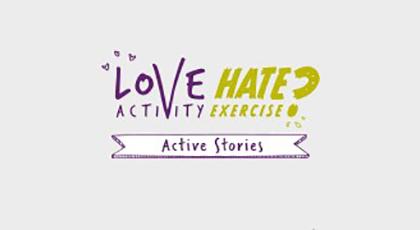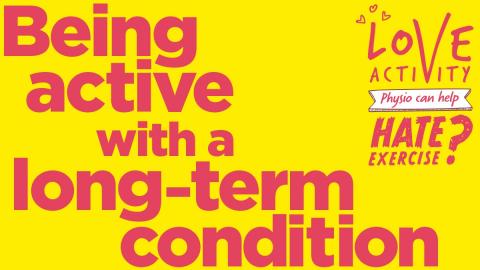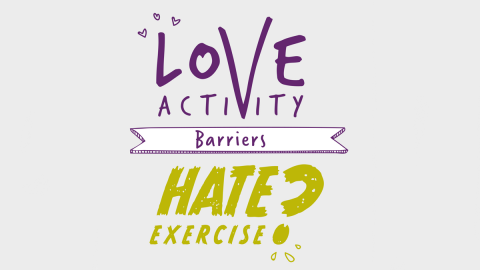From lower back pain to fractured collarbones, physiotherapy helps with a host of common cycling injuries. Get the expert view below.
On this page:
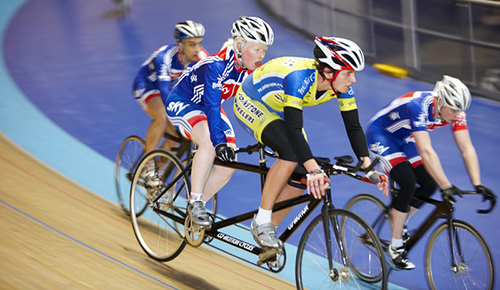
Cycling regularly brings enormous and varied benefits for your health at all ages, whether riding for recreation, as a serious competitor, or racing to win the Tour de France.
And physiotherapists can use their knowledge and expertise to provide guidance on cycling posture and the set up of your bike to ensure you enjoy those benefits in a pain-free way.
But as with any sport, there are common injuries that cyclists incur that may require the help of a physiotherapist. Broadly, these injuries fall into two main categories: overuse and traumatic.
Overuse injuries most commonly includes knee pain, back pain, and Achilles tendon problems.
Cycling is a highly repetitive sport – an average cyclist might perform well over 5,000 revolutions an hour so it is quite understandable how small problems can become bigger issues over time.
Traumatic injuries are most commonly as a result of accidents from falls and crashes.
Cycling is a very safe sport, but as with anything it pays to be aware of your own abilities, to be aware of the environment around you, and to take appropriate safety precautions such as wearing a helmet.
The position you sit in on a bike can be incredibly important, especially when viewed in the context of cycling being so highly repetitive.
Below, Eric Clarke of The Association of Chartered Physiotherapists in Sports and Exercise Medicine sets out what some of the more common cycling related injuries are and how a physiotherapist can get you back in the saddle.
Bike set up
Inappropriate bicycle set up can often be linked to pain and injuries. Common factors are:
- the seat being too high or too low,
- the position of the foot on the pedal causing too much load into the foot or ankle,
- incorrect distance from the seat to the handlebars can put the body into a position that leads to excessive strain on joints of the shoulders, neck and lower back.
Fractured collarbone
What is it?
This is the most common fracture seen in cycling and usually happens when cyclists fall onto the point of the shoulder, referring the impact along the collarbone and causing it to break. The break can be very painful and is usually diagnosed by an x-ray.
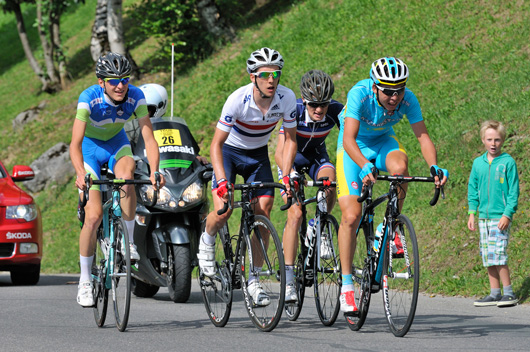
Rising British star Simon Yates (second from left) fractured his collarbone in April 2014.
(Photo: Georges Ménager)
How does physiotherapy treat a fractured collarbone?
Pain relief and immobilisation with a sling will be the first course of action. Sometimes, the position of the fracture may require surgery to insert a small plate to hold the bone in place whilst it heals.
The affected arm should remain in a sling for about four weeks, but during this time a physiotherapist can provide guidance on exercises that ensure the shoulder joint does not stiffen.
As the bone heals and the pain recedes, the physio can provide further exercises that focus on improving mobility, posture and strength to enable a return to the saddle for the cyclist.
This is very important as cyclists take a lot of weight through the arms, more than is commonly thought.
Scaphoid fracture
What is it?
The scaphoid is a small bone on the thumb side of the wrist that can fracture when a rider puts a hand out to break a fall.
Scaphoid fractures often do not show up on an immediate x-ray but will usually present in a follow-up 10-14 days later.
How does physiotherapy treat a scaphoid fracture?
Sometimes the bone will need surgery, but in most cases the wrist will be immobilised in a cast for at least six weeks to allow the bone to heal naturally.
Once the cast has been removed, a physio will guide the person through a series of exercises designed to regain strength in the forearm, wrist and hand.
This is very important as a cyclist needs good strength to control the brakes and gears, as well as to comfortably take weight through the wrist and control the steering of the bicycle.
Muscle contusion and bony bruises
What is it?
This is where a muscle or bony prominence - most often around the hip and thigh - gets bruised in a fall.
The impact of the fall can cause damage to the muscle or bone causing swelling and visible bruising, and often limits the amount of movement in that area.
How does physiotherapy treat a muscle contusion?
It’s important to apply ice as soon as possible and continue that for short periods over the first 24-48 hours.
Any cuts and grazes should be cleaned and dressed to prevent infection. More serious wounds, or wounds that have debris in them, should be seen to by a doctor.
During the day time, you should try to gently move the joint or muscle to prevent stiffness and to help reduce swelling.
Knee pain
What is it?
Knee pain is the most common pain seen in cyclists and is usually due to the highly repetitive motion of the knee flexing as the pedal goes round.
A knee normally moves over the toes as the pedal goes around, but excessive sideways motion of the knee, or poor bicycle set up can accentuate the forces going through the knee and lead to inflammation or wear and tear on the various structures around the knee.
A seat that is too high may lead to excessive strain on the ilio-tibial band (IT band) which a strong fibrous band that runs down the side of the thigh from the hip to the outside of the knee.
A seat that is too low can cause pain under or around the knee cap due to prolonged time spent pushing whilst too bent.
How does physiotherapy treat knee pain?
The physio will firstly assess the knee to diagnose the problem and advise treatment as suitable for the particular problem.
Once the diagnosis has been determined, a programme of rehabilitation involving manual therapy, stretching and strengthening exercises will be developed to alleviate the symptoms and enable the cyclist to return to cycling.
A physiotherapist experienced in assessing bicycle set up will also look at the position of the cyclist when riding to determine the root cause of the problem and may make suggestions to alleviate the strains on the knee resulting from the position on the bike, such as small changes to seat position.
Neck pain
What is it?
This is generally caused by poor posture in the saddle or too much time spent in a bad position, reduced flexibility in the upper back, or a fault with the set-up of the bike itself that can exacerbate the problem.
The pain can spread around the region and sometimes can also lead to numbness or tingling in the arms.
How does physiotherapy treat neck pain?
A physiotherapist will assess the neck to produce a diagnosis and once this has been determined, a programme of rehabilitation involving manual therapy, stretching and strengthening exercises will be developed to alleviate the symptoms and enable the cyclist to hold a better posture in the saddle.
The physio will also look at the position of the cyclist when riding to determine the root cause of the problem.
If the position on the bike is causing the issue, then changes to such things as the saddle height or the handlebar position may be suggested.
Lower back pain
What is it?
This is very common among cyclists because the back is held in a ‘flexed’ position for long periods.
For many non-elite cyclists, it is also worth noting that the main cause of back pain may be the many other lifestyle activities such as prolonged sitting at work or heavy lifting, and that cycling is merely a factor that aggravates the problem.
A sustained flexed position can compress the discs of the spine or place an excessive strain on muscles and ligaments which over time can lead to pain.
The pain itself can sometimes spread from the back to the buttocks, and along the leg.
How does physiotherapy treat back pain?
A physio will assess the cyclist’s posture both on and off the bike to see which aspects are contributing to the problem.
If the position in the saddle is causing the problem, they may suggest changes which can reduce the strain on the back or make cycling more comfortable.
Manual therapy, mobility exercises and stretching will be used to improve movement, not only in the back but also in the gluteals, hamstrings, hip flexors and thighs where tightness could be a contributing factor.
Core strength should be developed to help the cyclist maintain a good position in the saddle and to support the back during longer periods on the bike.
Achilles pain
What is it?
Often called Achilles tendonitis, this is characterised by pain in the Achilles tendon which runs down the back of the leg from the calf to the heel, and can develop inflammation and other problems through overuse.
How does physiotherapy treat Achilles pain?
Pain management through icing and reduced loading will be the initial approach, coupled with a rehabilitation program of specific exercises to help encourage repair of the damaged fibres in the tendon and strengthen the calf muscles.
The physio may also look at taping the affected area to allow a return to cycling.
Foot pain
What is it?
Some cyclists suffer pain as a result of the constant pressure being applied through the front of the foot during pedalling.
This can be pain of the soft tissues under the forefoot, but sometimes may involve damage to the nerves which run between the toes.
How does physiotherapy treat foot pain?
As this condition is often caused by the wrong footwear or incorrectly positioned cleats, the physio will assess the cyclist’s position in the saddle and look specifically at how the cyclist pushes through their feet.
Adjustments may be made based on those results and the pain should ease.
If this is not sufficient to alleviate the problem, sometimes inserts inside the shoe may help control the foot position enough to spread the pressure to other parts of the foot.
Do you need a physio to help with a cycling injury? Try our Physio2u directory.





































